- Home
- HashiCorp
- HashiCorp Security Automation Certification
- Vault-Associate
- Vault-Associate - HashiCorp Certified: Vault Associate (002)
HashiCorp Vault-Associate HashiCorp Certified: Vault Associate (002) Exam Practice Test
HashiCorp Certified: Vault Associate (002) Questions and Answers
You have been tasked with writing a policy that will allow read permissions for all secrets at path secret/bar. The users that are assigned this policy should also be able to list the secrets. What should this policy look like?
Options:
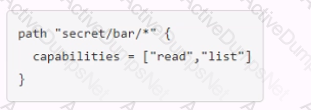
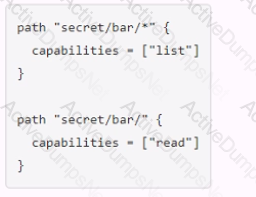
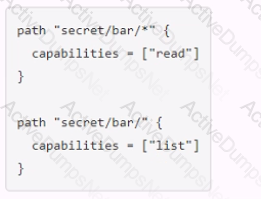
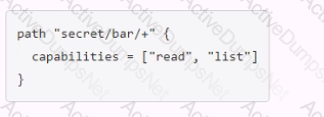
Answer:
CExplanation:
This policy would allow read permissions for all secrets at path secret/bar, as well as list permissions for the secret/bar/ path. The list permission is required to be able to see the names of the secrets under a given path1. The wildcard () character matches any number of characters within a single path segment, while the slash (/) character matches the end of the path2. Therefore, the policy would grant read access to any secret that starts with secret/bar/, such as secret/bar/foo or secret/bar/baz, but not to secret/bar itself. To grant list access to secret/bar, the policy needs to specify the exact path with a slash at the end. This policy follows the principle of least privilege, which means that it only grants the minimum permissions necessary for the users to perform their tasks3.
The other options are not correct because they either grant too much or too little permissions. Option A would grant both read and list permissions to all secrets under secret/bar, which is more than what is required. Option B would grant list permissions to all secrets under secret/bar, but only read permissions to secret/bar itself, which is not what is required. Option D would use an invalid character (+) in the policy, which would cause an error.
References:
- Policy Syntax | Vault | HashiCorp Developer
- Policy Syntax | Vault | HashiCorp Developer
- Policies | Vault | HashiCorp Developer
Which of the following vault lease operations uses a lease_id as an argument? Choose two correct answers.
Options:
renew
revoke -prefix
create
describe
revoke
Answer:
A, EExplanation:
The vault lease operations that use a lease_id as an argument are renew and revoke. The renew operation allows a client to extend the validity of a lease associated with a secret or a token. The revoke operation allows a client to terminate a lease immediately and invalidate the secret or the token. Both operations require a lease_id as an argument to identify the lease to be renewed or revoked. The lease_id can be obtained from the response of reading a secret or creating a token, or from the vault lease list command. The other operations, revoke-prefix, create, and describe, do not use a lease_id as an argument. The revoke-prefix operation allows a client to revoke all secrets or tokens generated under a given prefix. The create operation allows a client to create a new lease for a secret. The describe operation allows a client to view information about a lease, such as its TTL, policies, and metadata. References: Lease, Renew, and Revoke | Vault | HashiCorp Developer, vault lease - Command | Vault | HashiCorp Developer
What does the following policy do?

Options:
Grants access for each user to a KV folder which shares their id
Grants access to a special system entity folder
Allows a user to read data about the secret endpoint identity
Nothing, this is not a valid policy
Answer:
CExplanation:
This policy allows a user to read data about the secret endpoint identity. The policy grants the user the ability to create, update, read, and delete data in the “secret/data/{identity.entity.id}” path. Additionally, the user is allowed to list data in the “secret/metadata/{identity.entity.id}” path. This policy is useful for users who need to access information about the secret endpoint identity.
The secret endpoint identity is a feature of the Identity Secrets Engine, which allows Vault to generate identity tokens that can be used to access other Vault secrets engines or namespaces. The identity tokens are based on the entity and group information of the user or machine that authenticates with Vault. The entity is a unique identifier for the user or machine, and the group is a collection of entities that share some common attributes. The identity tokens can carry metadata and policies that are associated with the entity and group.
The “secret/data/{identity.entity.id}” path is where the user can store and retrieve data that is related to the secret endpoint identity. For example, the user can store some configuration or preferences for the secret endpoint identity in this path. The “secret/metadata/{identity.entity.id}” path is where the user can list the metadata of the data stored in the “secret/data/{identity.entity.id}” path. For example, the user can list the version, creation time, deletion time, and destroy time of the data in this path.
References:
- [Identity - Secrets Engines | Vault | HashiCorp Developer]
- [KV - Secrets Engines | Vault | HashiCorp Developer]
Which of the following is a machine-oriented Vault authentication backend?
Options:
Okta
AppRole
Transit
GitHub
Answer:
BExplanation:
AppRole is a machine-oriented authentication method that allows machines or applications to authenticate with Vault using a role ID and a secret ID. The role ID is aunique identifier for the application, and the secret ID is a single-use credential that can be delivered to the application securely. AppRole is designed to provide secure introduction of machines and applications to Vault, and to support the principle of least privilege by allowing fine-grained access control policies to be attached to each role1.
Okta, GitHub, and Transit are not machine-oriented authentication methods. Okta and GitHub are user-oriented authentication methods that allow users to authenticate with Vault using their Okta or GitHub credentials23. Transit is not an authentication method at all, but a secrets engine that provides encryption as a service4.
References:
- AppRole Auth Method | Vault | HashiCorp Developer
- Okta Auth Method | Vault | HashiCorp Developer
- GitHub Auth Method | Vault | HashiCorp Developer
- Transit Secrets Engine | Vault | HashiCorp Developer
Which Vault secret engine may be used to build your own internal certificate authority?
Options:
Transit
PKI
PostgreSQL
Generic
Answer:
BExplanation:
The Vault secret engine that can be used to build your own internal certificate authority is the PKI secret engine. The PKI secret engine generates dynamic X.509 certificates on-demand, without requiring manual processes of generating private keys and CSRs, submitting to a CA, and waiting for verification and signing. The PKI secret engine can act as a root CA or an intermediate CA, and can issue certificates for various purposes, such as TLS, code signing, email encryption, etc. The PKI secret engine can also manage the certificate lifecycle, such as rotation, revocation, renewal, and CRL generation. The PKI secret engine can also integrate with external CAs, such as Venafi or Entrust, to delegate the certificate issuance and management. References: PKI - Secrets Engines | Vault | HashiCorp Developer, Build Your Own Certificate Authority (CA) | Vault - HashiCorp Learn
When using Integrated Storage, which of the following should you do to recover from possible data loss?
Options:
Failover to a standby node
Use snapshot
Use audit logs
Use server logs
Answer:
BExplanation:
Integrated Storage is a Raft-based storage backend that allows Vault to store its data internally without relying on an external storage system. It also enables Vault to run in high availability mode with automatic leader election and failover. However, Integrated Storage is not immune to data loss or corruption due to hardware failures, network partitions, or human errors. Therefore, it is recommended to use the snapshot feature to backup and restore the Vault data periodically or on demand. A snapshot is a point-in-time capture of the entire Vault data, including the encrypted secrets, the configuration, and the metadata. Snapshots can be taken and restored using the vault operator raft snapshot command or the sys/storage/raft/snapshot API endpoint. Snapshots are encrypted and can only be restored with a quorum of unseal keys or recovery keys. Snapshots are also portable and can be used to migrate data between different Vault clusters or storage backends. References: https://developer.hashicorp.com/vault/docs/concepts/integrated-storage 1, https://developer.hashicorp.com/vault/docs/commands/operator/raft/snapshot 2, https://developer.hashicorp.com/vault/api-docs/system/storage/raft/snapshot 3
The key/value v2 secrets engine is enabled at secret/ See the following policy:

Which of the following operations are permitted by this policy? Choose two correct answers.
Options:
vault kv get secret/webapp1
vault kv put secret/webapp1 apikey-"ABCDEFGHI] K123M"
vault kv metadata get secret/webapp1
vault kv delete secret/super-secret
vault kv list secret/super-secret
Answer:
A, CExplanation:
The policy shown in the image is:
path “secret/data/webapp1” { capabilities = [“create”, “read”, “update”, “delete”, “list”] }
path “secret/data/super-secret” { capabilities = [“deny”] }
This policy grants or denies access to the key/value v2 secrets engine mounted at secret/ according to the following rules:
- The path “secret/data/webapp1” has the capabilities of “create”, “read”, “update”, “delete”, and “list”. This means that the policy allows performing any of these operations on the secrets stored under this path. The data/ prefix is used to access the actual secret data in the key/value v2 secrets engine5. Therefore, the policy permits the operation of vault kv get secret/webapp1, which reads the secret data at secret/data/webapp16.
- The path “secret/data/super-secret” has the capability of “deny”. This means that the policy denies performing any operation on the secrets stored under this path. The policy overrides any other policy that might grant access to this path. Therefore, the policy does not permit the operations of vault kv delete secret/super-secret and vault kv list secret/super-secret, which delete and list the secret data at secret/data/super-secret respectively6.
- The policy does not explicitly define any rules for the path “secret/metadata”. The metadata/ prefix is used to access the metadata of the secrets in the key/value v2 secrets engine, such as the number of versions, the deletion status, the creation time, etc5. By default, if the policy grants any of the capabilities of “create”, “read”, “update”, or “delete” on the data/ path, it also grants the same capabilities on the corresponding metadata/ path7. Therefore, the policy permits the operation of vault kv metadata get secret/webapp1, which reads the metadata of the secret at secret/metadata/webapp18.
References: 5(https://developer.hashicorp.com/vault/docs/secrets/kv/kv-v2), [ 6]6, 7(https://developer.hashicorp.com/vault/docs/secrets/kv/kv-v2), [ 8]8
Where do you define the Namespace to log into using the Vault Ul?
To answer this question
Use your mouse to click on the screenshot in the location described above. An arrow indicator will mark where you have clicked. Click the "Answer" button once you have positioned the arrow to answer the question. You may need to scroll down to see the entire screenshot.
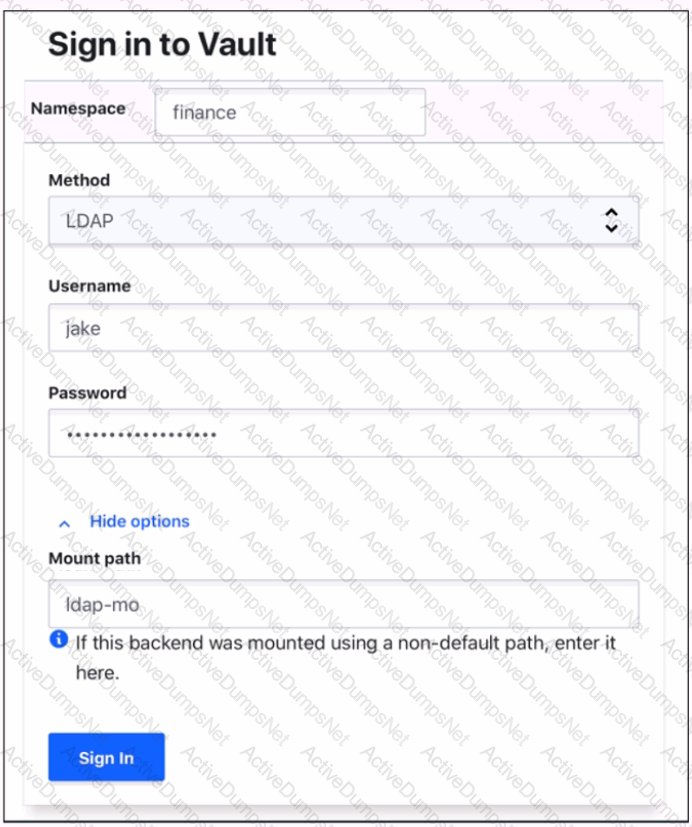
Options:
Answer:

Explanation:
The namespace can be defined in the “Mount path” field in the “Advanced options” section of the login screen. The mount path is the path where the auth method is enabled, and it can include a namespace prefix. For example, if the LDAP auth method is enabled at the pathns1/auth/ldap, where ns1 is the namespace, then the mount path field should be set to ns1/auth/ldap. This way, the Vault UI will log in to the correct namespace and auth method. Alternatively, the namespace can also be specified in the URL of the Vault UI, such as https://vault.example.com/ui/vault/auth/ns1/auth/ldap/login.
Which of these is not a benefit of dynamic secrets?
Options:
Supports systems which do not natively provide a method of expiring credentials
Minimizes damage of credentials leaking
Ensures that administrators can see every password used
Replaces cumbersome password rotation tools and practices
Answer:
CExplanation:
Dynamic secrets are generated on-demand by Vault and have a limited time-to-live (TTL). They do not ensure that administrators can see every password used, as they are often encrypted and ephemeral. The benefits of dynamic secrets are:
- They support systems that do not natively provide a method of expiring credentials, such as databases, cloud providers, SSH, etc. Vault can revoke the credentials when they are no longer needed or when the lease expires.
- They minimize the damage of credentials leaking, as they are short-lived and can be easily rotated or revoked. If a credential is compromised, the attacker has a limited window of opportunity to use it before it becomes invalid.
- They replace cumbersome password rotation tools and practices, as Vault can handle the generation and revocation of credentials automatically and securely. This reduces the operational overhead and complexity of managing secrets.
References: https://developer.hashicorp.com/vault/tutorials/getting-started/getting-started-dynamic-secrets 1, https://developer.hashicorp.com/vault/docs/concepts/lease 2
Which of the following describes usage of an identity group?
Options:
Limit the policies that would otherwise apply to an entity in the group
When they want to revoke the credentials for a whole set of entities simultaneously
Audit token usage
Consistently apply the same set of policies to a collection of entities
Answer:
DExplanation:
An identity group is a collection of entities that share some common attributes. An identity group can have one or more policies attached to it, which are inherited by all the members of the group. An identity group can also have subgroups, which can further refine the policies and attributes for a subset of entities.
One of the use cases of an identity group is to consistently apply the same set of policies to a collection of entities. For example, an organization may have different teams or departments, such as engineering, sales, or marketing. Each team may have its own identity group, with policies that grant access to the secrets and resources that are relevant to their work. By creating an identity group for each team, the organization can ensure that the entities belonging to each team have the same level of access and permissions, regardless of which authentication method they use to log in to Vault. References: Identity: entities and groups | Vault | HashiCorp Developer, vault_identity_group | Resources | hashicorp/vault | Terraform | Terraform Registry
Where can you set the Vault seal configuration? Choose two correct answers.
Options:
Cloud Provider KMS
Vault CLI
Vault configuration file
Environment variables
Vault API
Answer:
C, DExplanation:
The Vault seal configuration can be set in two ways: through the Vault configuration file or through environment variables. The Vault configuration file is a text file that contains the settings and options for Vault, such as the storage backend, the listener, the telemetry, and the seal. The seal stanza in the configuration file specifies the seal type and the parameters to use for additional data protection, such as using HSM or Cloud KMS solutions to encrypt and decrypt the root key. The seal configuration can also be set through environment variables, which will take precedence over the values in the configuration file. The environment variables are prefixed with VAULT_SEAL_ and followed by the seal type and the parameter name. For example, VAULT_SEAL_AWSKMS_REGION sets the region for the AWS KMS seal. References: Seals - Configuration | Vault | HashiCorp Developer, Environment Variables | Vault | HashiCorp Developer
Which of the following cannot define the maximum time-to-live (TTL) for a token?
Options:
By the authentication method t natively provide a method of expiring credentials
By the client system f credentials leaking
By the mount endpoint configurationvery password used
A parent token TTL e password rotation tools and practices
System max TTL
Answer:
BExplanation:
The maximum time-to-live (TTL) for a token is defined by the lowest value among the following factors:
- The authentication method that issued the token. Each auth method can have a default and a maximum TTL for the tokens it generates. These values can be configured by the auth method’s mount options or by the auth method’s specific endpoints.
- The mount endpoint configuration that the token is accessing. Each secrets engine can have a default and a maximum TTL for the leases it grants. These values can be configured by the secrets engine’s mount options or by the secrets engine’s specific endpoints.
- A parent token TTL. If a token is created by another token, it inherits the remaining TTL of its parent token, unless the parent token has an infinite TTL (such as the root token). A child token cannot outlive its parent token.
- System max TTL. This is a global limit for all tokens and leases in Vault. It can be configured by the system backend’s max_lease_ttl option.
The client system that uses the token cannot define the maximum TTL for the token, as this is determined by Vault’s configuration and policies. The client system can only request a specific TTL for the token, but this request is subject to the limits imposed by the factors above.
References: https://developer.hashicorp.com/vault/docs/concepts/tokens 3, https://developer.hashicorp.com/vault/docs/concepts/lease 2, https://developer.hashicorp.com/vault/docs/commands/auth/tune 4, https://developer.hashicorp.com/vault/docs/commands/secrets/tune 5, https://developer.hashicorp.com/vault/docs/commands/token/create 6
An organization would like to use a scheduler to track & revoke access granted to a job (by Vault) at completion. What auth-associated Vault object should be tracked to enable this behavior?
Options:
Token accessor
Token ID
Lease ID
Authentication method
Answer:
CExplanation:
A lease ID is a unique identifier that is assigned by Vault to every dynamic secret and service type authentication token. A lease ID contains information such as the secret path, the secret version, the secret type, etc. A lease ID can be used to track and revoke access granted to a job by Vault at completion, as it allows the scheduler to perform the following operations:
- Lookup the lease information by using the vault lease lookup command or the sys/leases/lookup API endpoint. This will return the metadata of the lease, such as the expire time, the issue time, the renewable status, and the TTL.
- Renew the lease if needed by using the vault lease renew command or the sys/leases/renew API endpoint. This will extend the validity of the secret or the token for a specified increment, or reset the TTL to the original value if no increment is given.
- Revoke the lease when the job is completed by using the vault lease revoke command or the sys/leases/revoke API endpoint. This will invalidate the secret or the token immediately and prevent any further renewals. For example, with the AWS secrets engine, the access keys will be deleted from AWS the moment a lease is revoked.
A lease ID is different from a token ID or a token accessor. A token ID is the actual value of the token that is used to authenticate to Vault and perform requests. A token ID should be treated as a secret and protected from unauthorized access. A token accessor is a secondary identifier of the token that is used for token management without revealing the token ID. A token accessor can be used to lookup, renew, or revoke a token, but not to authenticate to Vault or access secrets. A token ID or a token accessor can be used to revoke the token itself, but not the leases associated with the token. To revoke the leases, a lease ID is required.
An authentication method is a way to verify the identity of a user or a machine and issue a token with appropriate policies and metadata. An authentication method is not an object that can be tracked or revoked, but a configuration that can be enabled, disabled, tuned, or customized by using the vault auth commands or the sys/auth API endpoints.
References: (https://developer.hashicorp.com/vault/docs/commands/lease/lookup), (https://developer.hashicorp.com/vault/docs/commands/lease/renew), (https://developer.hashicorp.com/vault/docs/commands/lease/revoke), (https://developer.hashicorp.com/vault/docs/concepts/tokens#token-accessors), (https://developer.hashicorp.com/vault/docs/concepts/auth)
Which of the following are replication methods available in Vault Enterprise? Choose two correct answers.
Options:
Cluster sharding
Namespaces
Performance Replication
Disaster Recovery Replication
Answer:
C, DExplanation:
The replication methods available in Vault Enterprise are performance replication and disaster recovery replication. These methods allow critical data to be replicated across clusters to support horizontally scaling and disaster recovery workloads.
- Performance replication enables a primary cluster to replicate data to one or more secondary clusters, which can handle client requests and improve performance and availability. Performance replication replicates most Vault data, such as secrets, policies, auth methods, and leases, but not tokens. Performance secondaries generate their own tokens and leases, which are not replicated back to the primary. Performance replication also supports filtering, which allows selective replication of data based on namespaces or paths.
- Disaster recovery replication enables a primary cluster to replicate data to one or more secondary clusters, which act as standby clusters in case of a failure or outage of the primary. Disaster recovery replication replicates all Vault data, including tokens and leases, and maintains the same configuration and state as the primary. Disaster recovery secondaries do not handle client requests, but they can be promoted to a primary in a disaster recovery scenario. References: Replication - Vault Enterprise | Vault | HashiCorp Developer, Performance Replication - Vault Enterprise | Vault | HashiCorp Developer, Disaster Recovery Replication - Vault Enterprise | Vault | HashiCorp Developer
How would you describe the value of using the Vault transit secrets engine?
Options:
Vault has an API that can be programmatically consumed by applications
The transit secrets engine ensures encryption in-transit and at-rest is enforced enterprise wide
Encryption for application data is best handled by a storage system or database engine, while storing encryption keys in Vault
The transit secrets engine relieves the burden of proper encryption/decryption from application developers and pushes the burden onto the operators of Vault
Answer:
DExplanation:
The transit secrets engine relieves the burden of proper encryption/decryption from application developers and pushes the burden onto the operators of Vault. The transit secrets engine provides encryption as a service, which means that it performs cryptographic operations on data in-transit without storing any data. This allows developers to delegate the responsibility of managing encryption keys and algorithms to Vault operators, who can define and enforce policies on the transit secrets engine. This way, developers can focus on their application logic and data, while Vault handles the encryption and decryption of data in a secure and scalable manner. References: Transit - Secrets Engines | Vault | HashiCorp Developer, Encryption as a service: transit secrets engine | Vault | HashiCorp Developer
When creating a policy, an error was thrown:
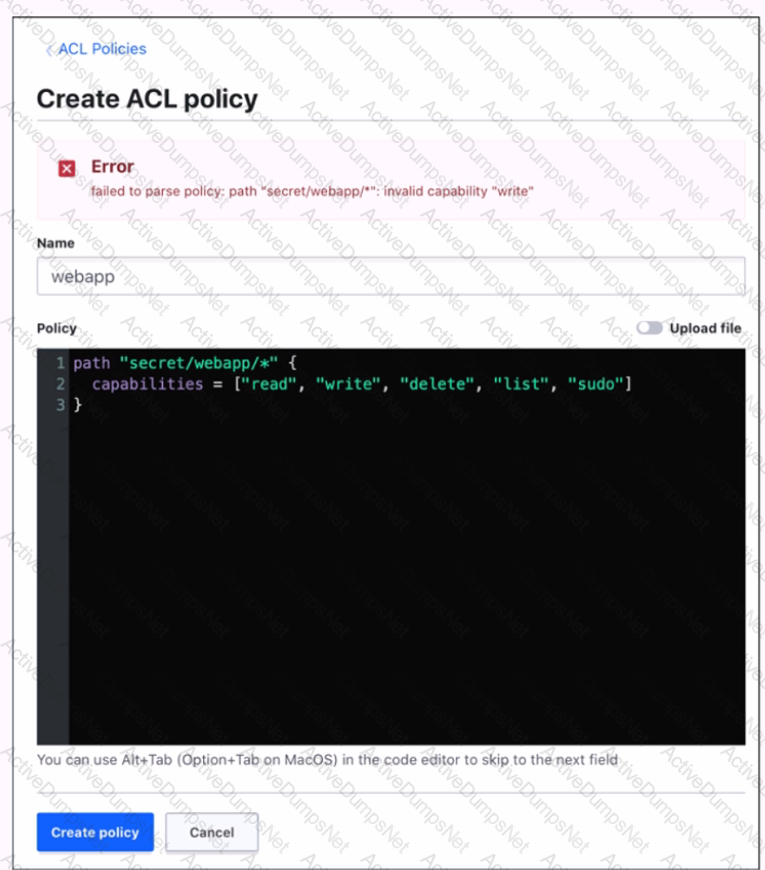
Which statement describes the fix for this issue?
Options:
Replace write with create in the capabilities list
You cannot have a wildcard (" • ") in the path
sudo is not a capability
Answer:
AExplanation:
The error was thrown because the policy code contains an invalid capability, “write”. The valid capabilities for a policy are “create”, “read”, “update”, “delete”, “list”, and “sudo”. The “write” capability is not recognized by Vault and should be replaced with “create”, which allows creating new secrets or overwriting existing ones. The other statements are not correct, because the wildcard (*) and the sudo capability are both valid in a policy. The wildcard matches any number of characters within a path segment, and the sudo capability allows performing certain operations that require root privileges.
References:
- [Policy Syntax | Vault | HashiCorp Developer]
- [Policy Syntax | Vault | HashiCorp Developer]
Which of these are a benefit of using the Vault Agent?
Options:
Vault Agent allows for centralized configuration of application secrets engines
Vault Agent will auto-discover which authentication mechanism to use
Vault Agent will enforce minimum levels of encryption an application can use
Vault Agent will manage the lifecycle of cached tokens and leases automatically
Answer:
DExplanation:
Vault Agent is a client daemon that provides the following features:
- Auto-Auth - Automatically authenticate to Vault and manage the token renewal process for locally-retrieved dynamic secrets.
- API Proxy - Allows Vault Agent to act as a proxy for Vault’s API, optionally using (or forcing the use of) the Auto-Auth token.
- Caching - Allows client-side caching of responses containing newly created tokens and responses containing leased secrets generated off of these newly created tokens. The agent also manages the renewals of the cached tokens and leases.
- Templating - Allows rendering of user-supplied templates by Vault Agent, using the token generated by the Auto-Auth step.
- Process Supervisor Mode - Runs a child process with Vault secrets injected as environment variables.
One of the benefits of using the Vault Agent is that it will manage the lifecycle of cached tokens and leases automatically. This means that the agent will handle the token renewal and revocation logic, as well as the lease renewal and revocation logic for the secrets that are cached by the agent. This reduces the burden on the application developers and operators, and ensures that the tokens and secrets are always valid and up-to-date. References: Vault Agent | Vault | HashiCorp Developer, Caching - Vault Agent | Vault | HashiCorp Developer
Unlock Vault-Associate Features
- Vault-Associate All Real Exam Questions
- Vault-Associate Exam easy to use and print PDF format
- Download Free Vault-Associate Demo (Try before Buy)
- Free Frequent Updates
- 100% Passing Guarantee by Activedumpsnet
Questions & Answers PDF Demo
- Vault-Associate All Real Exam Questions
- Vault-Associate Exam easy to use and print PDF format
- Download Free Vault-Associate Demo (Try before Buy)
- Free Frequent Updates
- 100% Passing Guarantee by Activedumpsnet
